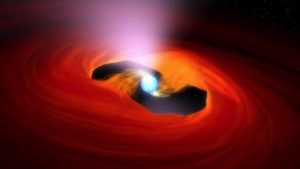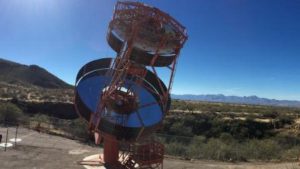Media
Transcript
Today is a day of cognitive dissonance for many of us. Currently, the American Astronomical Society is meeting virtually, with myriad astronomers from around the world coming together to celebrate our newest discoveries, our incremental advances in understanding, and to find tomorrow’s collaborators. This is a celebration of science.
At the same time, people are going to sleep to the sounds of gunfire here in the United States. I don’t know what is happening in the coming days, but I am proud of our peaceful protestors who are saying it is time for us to recognize that the police must stop murdering people and that we must recognize that black lives matter.
Before I get to the science results I need to say that science is worse off for the racism and biases limiting the options for so many people. We are an international program, and we know people in our community have experienced hate for myriad reasons. In this moment it is important for us to say, Black Lives Matter. One in one thousand black boys and men will be killed by police in the US. No life should be thrown away. When humans with the potential to be the next Albert Einstein or Chris Hadfield are being struck dead walking home with Twizzlers, and sometimes just die dancing or playing in the park… I have no words to express my sorrow. Our support does not say these lives matter more than others, but rather we recognize that culturally (in different ways in different places), some populations are treated as though they matter less. This is wrong. We are proud of the people within CosmoQuest who are peacefully participating in the Black Lives Matter movement, in Pride celebrations, and those who are opening their homes and communities to people escaping potential death in their native lands. We see your compassion and commend it.

The science we bring you today comes from people all over the world, and we start with a story from Monash University in Australia. Graduate student Adelle Goodwin has made the first-ever start-to-finish observations of a cataclysmic variable star. This system consists of a neutron star, a regular companion star, and a whole lot of gravity that is tearing material off the companion star and pulling it into a disk around the neutron star. As this disk grows, it will dump material onto the surface of the neutron star. This isn’t a continuous process but occurs in spurts. For decades, folks have tried to catch these systems at the moment an outburst begins, and campaigns involving amateur astronomers monitoring these variables have been common. Despite all these efforts, no one had been able to acquire detailed observations across multiple-wavelengths… at least not until now.
In a new paper in the Monthly Notices of the Royal Astronomical Society, this team describes the behavior of a system captured at the moment the outburst. Over the course of twelve days, they performed high sensitivity optical and X-Ray observations as material swirled inward to collide with the neutron star surface. This twelve-day duration was the first of their discoveries! It had previously been thought that outbursts consistently lasted two to three days! According to Goodwin, “Using multiple telescopes that are sensitive to light in different energies we were able to trace that the initial activity happened near the companion star, in the outer edges of the accretion disk, and it took twelve days for the disk to be brought into the hot state and for material to spiral inward to the neutron star, and X-rays to be produced”.
This science required five ground- and two space-based telescopes. This arrangement gave continuous coverage over many different wavelengths of light. This system is 11,000 lightyears away, and the neutron star is a special kind of neutron star – a pulsar that rotates 400 times a second!
This theory defying slow burn and burst pointed toward something being out of spec with this system. Thanks to the tremendous data set they acquired, it was possible to measure the composition of the material in the disc, and they discovered it had a much higher helium content than has been observed in other systems. While most accretion disks are primarily hydrogen, this disc was measured to be 50% helium, a gas that burns at a hotter temperature. Just as it can take longer to preheat your oven to higher temperatures, it takes longer to preheat a disk to detonation temperatures. This twelve-day duration reflects the higher temperature needed to trigger the helium.
While this paper largely focuses on the observations, we expect more to come as Adelle finishes her Ph.D. and, we hope, more systems receive this kind of intensive observation.

From global observations of one system, we now turn to Arizona observations of one object. For those observing gamma rays, there is a new telescope array in town. The prototype Schwarzchild-Couder Telescope is testing a new design for detecting the cascades of light created when high-energy gamma rays strike our atmosphere. Called Cherenkov Radiation, these cascades can be seen streaming away from their origin point on the sky. Until now, the systems used to detect these cascades consisted of massive multi-segment detectors and a prime focus camera that hung awkwardly above the dish. This new system, for the first time, uses a secondary mirror to reflect the light through the segmented reflector, and to instruments below. This allows bigger detectors to be used and grants easier access to the system, allowing easier innovation. To prove their system worked, the Cherenkov telescope array team pointed their scope at the Crab Nebula, one of the nearest sources of massively high-energy particles. And… they were not disappointed. Their prototype system is working nicely and now the work on a larger system can start in earnest. When complete, they will be able to detect, via Cherenkov radiation, sources of the highest energy light in our universe, and we can’t wait to see what they find.

Our final story of the day carries us to the EU, and looks toward the sun. Most of us are familiar with sunspots – dark, cool blemishes on the surface of the Sun that appear and disappear. Now, astronomers using the European Southern Observatory telescopes announced that they have found stellar spots that are hotter and brighter than the surface of their stars. The stars, in this case, are “extreme horizontal branch stars”. They are half the mass of our Sun but four to five times hotter.
Usually, we observe these types of stars in our own galaxy with a companion star. They can also be found in globular clusters, and generally don’t seem to have companions. They do, however, change in brightness, and that is what attracted the attention of astronomers, who conducted long-term observations of these stars. The changes in brightness lasted days to weeks, and scientists like Simon Zaggia of the INAF Astronomical Observatory of Padua concluded “these stars must be plagued by spots!”
The spots on these extreme horizontal branch stars are much bigger than sunspots. They can take up a quarter of the surface of the star, which is why the star’s brightness changes as it rotates. Additionally, these stars showed signs of “superflares” – stellar flares similar to those we observe on the Sun but with ten million times the energy. Flares such as these are compelling evidence for magnetic fields in these smaller, hotter stars.
The big picture here is that, as former ESO fellow David Jones said, “changes in brightness of all hot stars … could be connected” and may help explain the existence of magnetic fields in other stars like white dwarfs.
This is the start of understanding one of the most complicated topics in astrophysics – magnetic fields. We’re glad someone other than us is making sense of these twisting fields.
And that rounds out our news for today.
We are currently waiting to get papers and press releases from the news that came out earlier today, and there will be an additional press conference at the American Astronomical Society today as well as two more tomorrow. What this means is Thursday the news will be rich while today is a bit lean. Tomorrow will be our regular Rocket Roundup.
Learn More
Astronomers capture a pulsar ‘powering up’
- Monash University press release (phys.org)
- “The Binary Evolution of SAX J1808.4-3658: Implications of an Evolved Donor Star,” A. J. Goodwin & T. E. Woods, 2020 May 6, Monthly Notices of the Royal Astronomical Society (Preprint on arxiv.org)
Scientists Detect Crab Nebula Using Innovative Gamma-Ray Telescope, Proving Technology Viability
- Center for Astrophysics | Harvard & Smithsonian press release
- Cherenkov Telescope Array press release
- The University of Utah press release
Hot stars are plagued by giant magnetic spots, ESO data shows
- European Southern Observatory press release
- “A Plague of Magnetic Spots Among the Hot Stars of Globular Clusters,” Y. Momany et al., 2020 June 1, Nature Astronomy (Preprint from ESO)
Credits
Written by Pamela Gay and Beth Johnson
Hosted by Pamela Gay
Audio and Video Editing by Ally Pelphrey
Content Editing by Beth Johnson
Intro and Outro music by Kevin MacLeod, https://incompetech.com/music/


 We record most shows live, on Twitch. Follow us today to get alerts when we go live.
We record most shows live, on Twitch. Follow us today to get alerts when we go live.